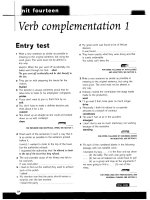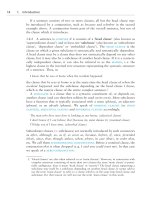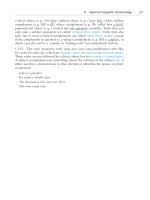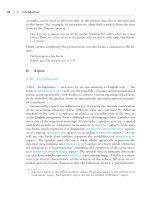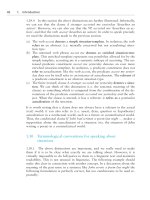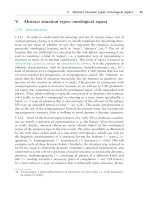Exploring grammar VERB TYPES
Bạn đang xem bản rút gọn của tài liệu. Xem và tải ngay bản đầy đủ của tài liệu tại đây (536.44 KB, 7 trang )
Exploring grammar - verb types
A recent discussion at GrammarGirl (link below) about the active voice talked a lot
about unaccusative verbs and semantic patients in its explanation. I'm not convinced of the
wisdom of using these specialist linguistic terms on a website read by a general audience of
native speakers and learners. I have a slight suspicion that more than a few will have been more
confused at the end than they were at the beginning.
But in the interests of understanding, I've tried to put these terms into some sort of scheme,
while at the same time looking at different terms used for types of verbs, both by linguists and
by more general grammar books. I hope this will be interesting, but I'm not suggesting that there
is any need for the general reader or learner to learn these specialist terms.
Disclaimer - Please don't take this as any kind of gospel. As usual, I make no claims to be either
a grammarian or a linguist. This is simply my way of trying to work it all out. Any linguists who
might happen to stumble on this are welcome to let me know if I've gone wrong.
We'll be looking briefly at the following:
Main (lexical) verbs and auxiliary (helping) verbs
Transitive, intransitive verbs and linking verbs
Subjects and objects, agents and targets (patients)
Ambitransitive and ergative verbs
Unaccusative verbs and unergative verbs
Empty verbs and inchoative verbs
Dynamic and stative verbs
Finite and non finite verbs forms
1. Basic verb patterns
You already know about transitive and intransitive verbs, linking verbs and auxiliaries, but here's
just a quick reminder:
1a - Main verbs, aka lexical verbs
Transitive verbs - these take at least one object, the direct object. Sometimes they take
a second object, either an indirect object or an object complement. See 7.
o
o
o
o
o
o
o
o
o
Peter loves Jane
David got a new bike for his birthday
Amanda has read three books this week
The sun has melted all the snow
Would you like to taste this soup?
Intransitive verbs - don't take an object
He has resigned from his job
He fell and broke his leg
Don't interrupt Amanda. She is reading
The snow has completely melted in the hot sun
Linking verbs - take a subject complement
o
o
o
o
o
She is a doctor
She became a doctor when she finished her studies
He seems older than I remember
This soup tastes delicious
It's getting a bit cold
1b - Auxiliary verbs, aka helping verbs
o
o
o
Primary auxiliaries - do, be, have - used with main verbs to construct tenses
He doesn't smoke
She is coming now
Have you eaten?
Modal auxiliaries - can, could, will, would, shall, should, may, might, must, ought to used with main verbs to show modality
o
o
He can't drive
She might be late
o
You ought to book later
Semi-modals - need, dare - can be used like ordinary verbs with a primary auxiliary, or
like a modal
o
o
o
o
He doesn't need to come.
He needn't come.
She doesn't dare ask him.
She daren't ask him. (British English)
In this post I'll be mainly talking about transitive and intransitive verbs, and verbs which can be
both. I'll say just a little bit about linking verbs, as I've already dealt with them in some
detail here.
I won't be saying anything more about auxiliaries here, as this post is concerned only with main
verbs. Neither will I be discussing phrasal verbs, which I've discussed elsewhere.
2. Verbs can follow more than one pattern
The eagle-eyed among you will have noticed that I have used some verbs more than once:
Some verbs can be both transitive and intransitive
Amanda has read three books this week
Don't interrupt Amanda. She is reading
The sun has melted all the snow
The snow has completely melted in the hot sun
Some verbs can be both transitive and linking
Would you like to taste this soup?
This soup tastes delicious
David got a new bike for his birthday
It's getting a bit cold
I've already written about linking verbs in another post, so I won't say any more about them
here. Verbs which can be both transitive and intransitive are known as ambitransitive verbs, and
I'll be saying a little more about them in a minute.
3. Subjects and objects, agents and targets (patients)
You are of course familiar with subjects and objects, and you will have heard a bit about agents
when talking about the passive; but you probably haven't come across the idea of targets or
patients before.
3a Agents and targets with transitive verbs
Look at this sentence:
Mark read the book from cover to cover
Mark, the subject, is the doer, he does the reading. The doer is known as the the agent (in red),
So here the subject and the doer are the same.
The object of his reading, the book, is sometimes called the target (in green), or (especially by
linguists) the patient, or undergoer. I'll stick with target, as I think it's easier to understand. Here
the object and the target are the same thing.
But look what happens when we turn it into a passive:
The book has been read by millions of people
The book has been read all over the world
The subject is now the target, and the agent may follow the passive verb, linked to it with by, or
more commonly, not be mentioned at all.
In linguistics things get a little more complicated. Linguists call agent and patient
(target) semanticroles, but they don't think that these two cover all possibilities, so they have a
couple of other semantic roles as well. But I think these two are enough for our purposes.
3b Agents and targets with intransitive verbs
Look at these four sentences from the opening section
Mike has resigned from his job
Don't interrupt Amanda. She is reading
Pete fell and broke his leg
The snow has completely melted in the hot sun
While Mike and Amanda have obviously chosen to do what they do, Pete and the snow had no
choice in the matter. So Mike and She (Amanda) are seen by linguists as agents, but Pete and
the snow are seen as targets. When this happens the verbs are known by linguists
as unaccusative verbs
From now on I'll colour-code subjects and objects according to whether they
are agents or targets
4. Unaccusative verbs
As we have just seen, unaccusative verbs are intransitive verbs where the subject has no choice
in the matter, has no volition. The most commonly quoted examples are die, fall and suffer ; and
the intransitive forms of ergative verbs such as melt and break. We'll be looking at ergative verbs
in a minute.
He died at a young age
She fell from the horse
He is suffering from a severe hangover
My ice-cream has melted all over my clothes
The window broke in the storm
The vase fell and broke.
Unaccusative verbs cannot be passive
Unaccusative verbs, being intransitive, cannot of course be passive. However, because of their
apparent passivity, their lack of action, they are sometimes mistakenly identified as
grammatically passive. They are not. But as we'll see in the next section, ergative verbs
like break also have a transitive form which can be used in the passive form - The window was /
got broken in the storm
5. Ambitransitive verbs
Ambitransitive verbs are verbs which can be used both transitively and intransitively. They fall
into two types. Let's look at those sentences again:
Amanda has read three books this week
Don't interrupt Amanda. She is reading
The sun has melted all the snow
The snow has completely melted in the hot sun
5a. Ergative verbs
If you look at the second pair, with the verb melt, you will notice that the object of the transitive
verb in the first sentence, snow, has become the subject of the intransitive verb in the second
sentence. There are quite a few verbs that can be used this way, and they are known as ergative
verbs. I've already written a post on ergative verbs, so I'll just give a few examples here.
Little Jimmy broke the window - transitive
The window broke when little Jimmy threw a stone at it - unaccusative
The publishers have sold 10,000 copies of her new book - transitive
Her new book is selling really well - unaccusative
The pilot landed the damaged plane and taxied it over to the terminal - transitive
The damaged plane landed safely and taxied over to the terminal - unaccusative
5b. Unergative verbs
We can't do this with other ambitransitive verbs like read, understand, eat, follow, win. When
used intransitively, these are known by linguists as unergative verbs
He understood her very well - transitive
That's fine then; I completely understand - unergative
What are you eating? - transitive
Leave Sally alone; she's eating - unergative
We'll follow you later - transitive
You go now and we'll follow later - unergative
We're winning this match easily - transitive
Hooray! We've won again - unergative
5c. Passive with ambitransitive verbs
Remember that we can only make passive constructions with transitive verbs. We can make
passives from the transitive forms of both types of ambitransitive verbs:
Amanda has read three books this week
His book has been read by people all over the world
The sun has melted all the snow
The snow has been completely melted by the hot sun
6. Intransitive verbs
To recap a little, intransitive verbs are divided by linguists into two types: unergative and
unaccustive. These terms are really only used in linguistics, and there is absolutely no need for
EFL students to learn them. I put them in for reference (and interest's sake) only:
o
o
o
o
Unergative
She ran to the window
We talked all night
Unaccusative
He fell down the stairs
A bee dies when it uses its sting
Intransitive verbs cannot be passive
Remember that intransitive verbs cannot be used in the passive. But some intransitive verbs
have transitive forms or similar looking transitive forms, which can be used in the passive:
The race was run in record time
Several trees were felled in the storm
7. Transitive verbs
Transitive verbs can work in several ways:
Standard transitive - takes a direct object
o
I 've made a bit of a mess
o
He kissed her tenderly on the cheek.
Ditransitive - the verb takes a direct object and an indirect object (in orange)
o
He made her a cup of coffee
o
She gave him the book
Factitive - the verb takes two objects, the first being the direct object and the second
being the complement (in blue) of the first, and known as the object complement
o
o
o
They made him head boy of the school
She called her son Mike
Causative - the verb takes an object plus another verb phrase in the infinitive (in navy)
He made me do it
o
She told me to do it
o
We can also have passive-like causative constructions:
o
He is having his hair cut tomorrow
They are getting their new TV delivered tomorrow
o
Notice that some verbs can be used in more than one way: make, for example, can be used in
several different ways
I've written a post on causative verbs, which you can find here.
Transitive verbs and the passive
Where it makes sense, transitive verbs can of course be used in the passive:
A lot of smartphones are made in China
She had never been kissed like that before
The prize was given by a local store
The doing word is called a verb
He has been told not to do that I don't know how many times
8. Empty verbs
We often use common verbs like do, give, have, make or take with nouns instead of using an
action verb to talk about everyday actions
do
o
I'll go and do the shopping
I'll do the cleaning while you're out
o
give
o
Give me a call / ring today
Come and give me a hug
o
have
o
We'll have breakfast at eight
o
She's having a bath
make
o
I'm afraid I've made a mistake
I'm glad we had that little chat
o
o
o
take
We'll take a break now
Let's take a look at that shop over there
We could often use a verb instead:
We shopped till we dropped
He's cleaning the bathroom
She hugged the child
We chatted all night
In American English take is often used where in British English we use have.
Have a bath (UK) - Take a bath (US)
I'll probably do a post on these sometime, but meanwhile there's a link to an exercise below.
9. Inchoative verbs
Inchoative verbs describe a change of state
The snow melted
The apples have ripened
This wine ages well
My socks have shrunk
This milk has turned sour
The sky darkened
They can often also be ergative verbs, and some are linking verbs. See the links for a
comprehensive list (PDF).
10. Stative and dynamic verbs
Dynamic verbs - also called action verbs, they indicate an action, process or sensation
She walked up the path
She's having a bath
I've been thinking about that plan of yours
She hasn't been feeling well lately
Stative verbs - describe a state, situation or condition
She lives in an enormous house
She has a large bathroom in her house
I think that plan of yours is rather good
It appears to be rather a good plan
Note that some verbs can be used as both dynamic and stative verbs
Remember that stative verbs are not normally used in continuous (progressive) tenses.
11. Finite and non-finite verb forms
Finite verb forms
Look at this definition of finite verb from Oxford Advanced Learner's Dictionary:
a finite verb form or clause shows a particular tense, person and number.
He walked into the room. - past simple, 3rd person singular
I've bought a new car. - present perfect, 1st person singular
Are you two getting married next year? - present contimnuous, 2nd person plural
Non-finite verb forms (aka verbals)
Non-finite verb forms are are those forms of the verb that do not have a tense, person, or
number. There are three types:
Infinitives
Gerunds
Participles
